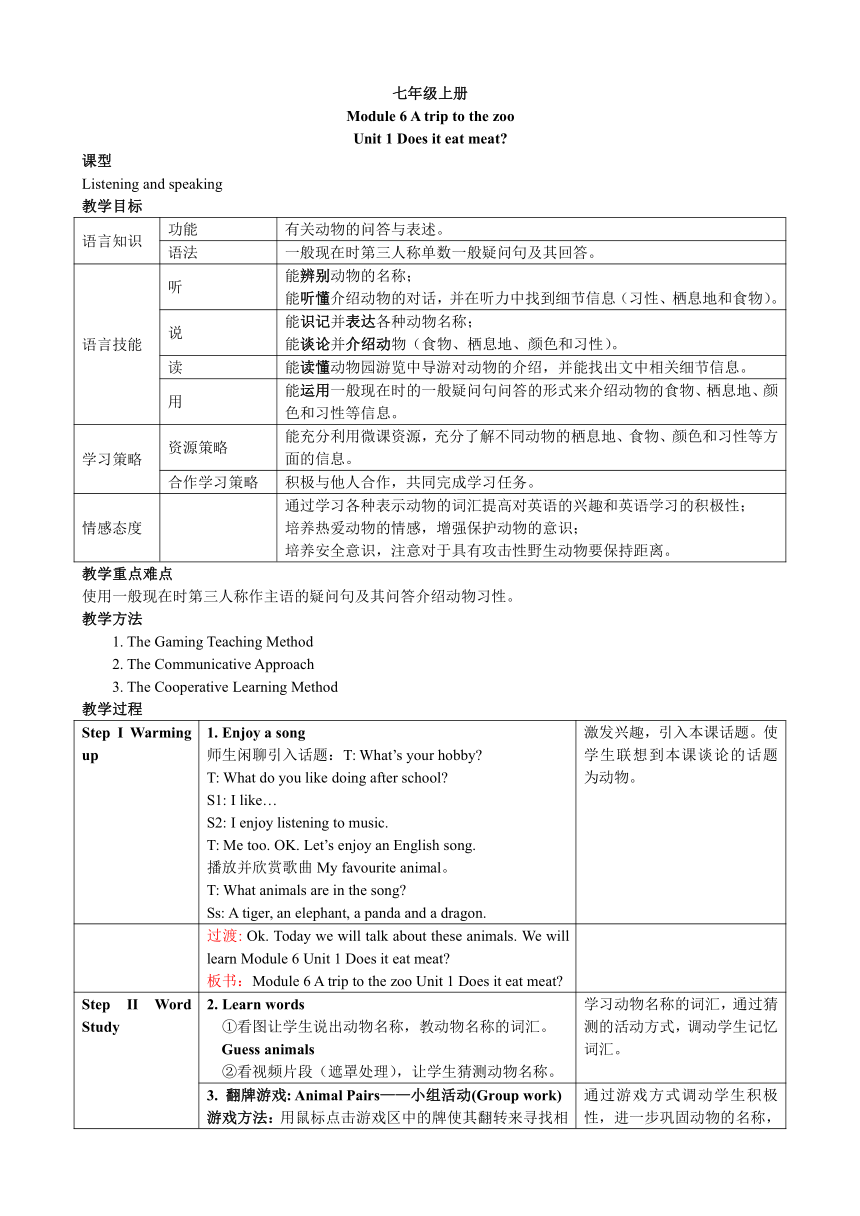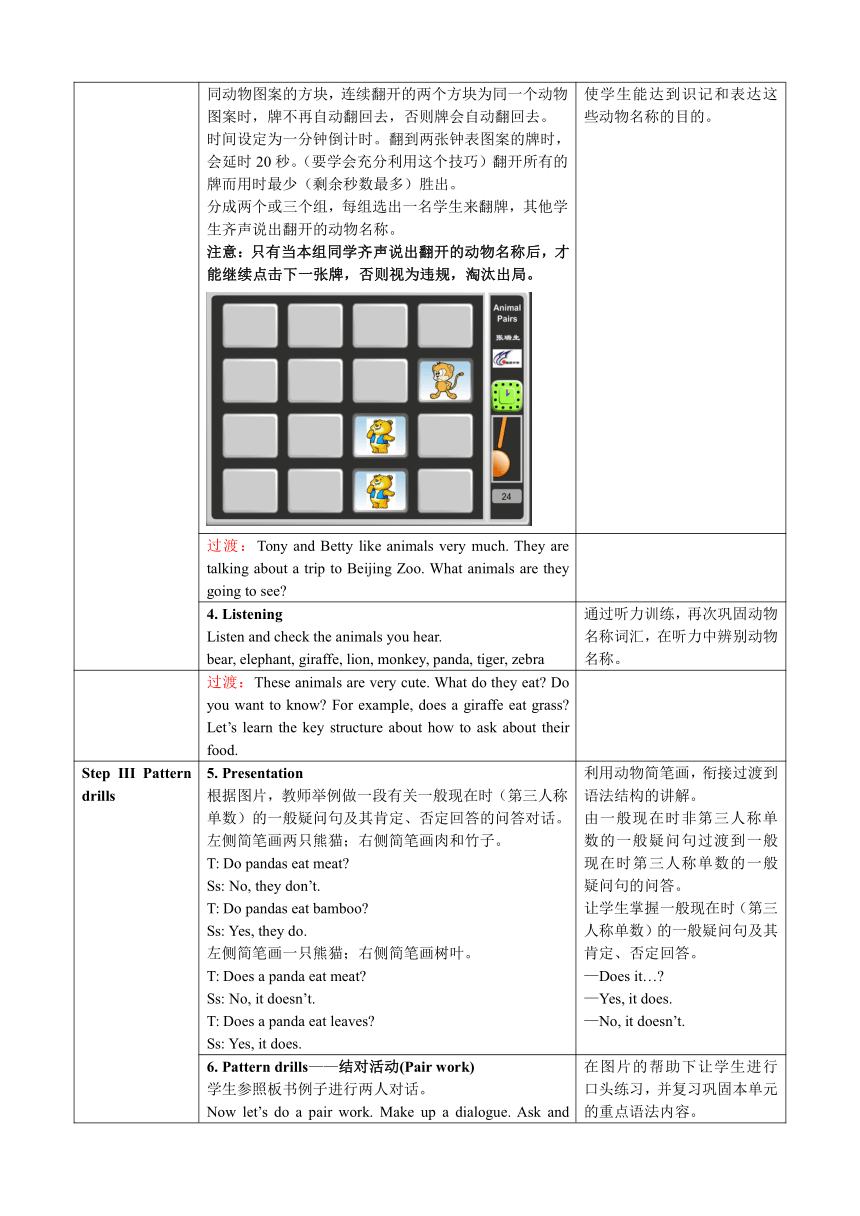外研版七上:Module 6 Unit 1 Unit 1 Does it eat meat?教学设计
文档属性
| 名称 | 外研版七上:Module 6 Unit 1 Unit 1 Does it eat meat?教学设计 |  | |
| 格式 | doc | ||
| 文件大小 | 1.2MB | ||
| 资源类型 | 教案 | ||
| 版本资源 | 外研版 | ||
| 科目 | 英语 | ||
| 更新时间 | 2020-09-24 08:37:05 | ||
图片预览


文档简介
七年级上册
Module 6 A trip to the zoo
Unit 1 Does it eat meat?
课型
Listening and speaking
教学目标
语言知识 功能 有关动物的问答与表述。
语法 一般现在时第三人称单数一般疑问句及其回答。
语言技能 听 能辨别动物的名称;
能听懂介绍动物的对话,并在听力中找到细节信息(习性、栖息地和食物)。
说 能识记并表达各种动物名称;
能谈论并介绍动物(食物、栖息地、颜色和习性)。
读 能读懂动物园游览中导游对动物的介绍,并能找出文中相关细节信息。
用 能运用一般现在时的一般疑问句问答的形式来介绍动物的食物、栖息地、颜色和习性等信息。
学习策略 资源策略 能充分利用微课资源,充分了解不同动物的栖息地、食物、颜色和习性等方面的信息。
合作学习策略 积极与他人合作,共同完成学习任务。
情感态度
通过学习各种表示动物的词汇提高对英语的兴趣和英语学习的积极性;
培养热爱动物的情感,增强保护动物的意识;
培养安全意识,注意对于具有攻击性野生动物要保持距离。
教学重点难点
使用一般现在时第三人称作主语的疑问句及其问答介绍动物习性。
教学方法
1. The Gaming Teaching Method
2. The Communicative Approach
3. The Cooperative Learning Method
教学过程
Step I Warming up 1. Enjoy a song
师生闲聊引入话题:T: What’s your hobby?
T: What do you like doing after school?
S1: I like…
S2: I enjoy listening to music.
T: Me too. OK. Let’s enjoy an English song.
播放并欣赏歌曲My favourite animal。
T: What animals are in the song?
Ss: A tiger, an elephant, a panda and a dragon. 激发兴趣,引入本课话题。使学生联想到本课谈论的话题为动物。
过渡: Ok. Today we will talk about these animals. We will learn Module 6 Unit 1 Does it eat meat?
板书:Module 6 A trip to the zoo Unit 1 Does it eat meat?
Step II Word Study 2. Learn words
①看图让学生说出动物名称,教动物名称的词汇。
Guess animals
②看视频片段(遮罩处理),让学生猜测动物名称。 学习动物名称的词汇,通过猜测的活动方式,调动学生记忆词汇。
3. 翻牌游戏: Animal Pairs——小组活动(Group work)
游戏方法:用鼠标点击游戏区中的牌使其翻转来寻找相同动物图案的方块,连续翻开的两个方块为同一个动物图案时,牌不再自动翻回去,否则牌会自动翻回去。
时间设定为一分钟倒计时。翻到两张钟表图案的牌时,会延时20秒。(要学会充分利用这个技巧)翻开所有的牌而用时最少(剩余秒数最多)胜出。
分成两个或三个组,每组选出一名学生来翻牌,其他学生齐声说出翻开的动物名称。
注意:只有当本组同学齐声说出翻开的动物名称后,才能继续点击下一张牌,否则视为违规,淘汰出局。
通过游戏方式调动学生积极性,进一步巩固动物的名称,使学生能达到识记和表达这些动物名称的目的。
过渡:Tony and Betty like animals very much. They are talking about a trip to Beijing Zoo. What animals are they going to see?
4. Listening
Listen and check the animals you hear.
bear, elephant, giraffe, lion, monkey, panda, tiger, zebra 通过听力训练,再次巩固动物名称词汇,在听力中辨别动物名称。
过渡:These animals are very cute. What do they eat? Do you want to know? For example, does a giraffe eat grass? Let’s learn the key structure about how to ask about their food.
Step III Pattern drills 5. Presentation
根据图片,教师举例做一段有关一般现在时(第三人称单数)的一般疑问句及其肯定、否定回答的问答对话。
左侧简笔画两只熊猫;右侧简笔画肉和竹子。
T: Do pandas eat meat?
Ss: No, they don’t.
T: Do pandas eat bamboo?
Ss: Yes, they do.
左侧简笔画一只熊猫;右侧简笔画树叶。
T: Does a panda eat meat?
Ss: No, it doesn’t.
T: Does a panda eat leaves?
Ss: Yes, it does. 利用动物简笔画,衔接过渡到语法结构的讲解。
由一般现在时非第三人称单数的一般疑问句过渡到一般现在时第三人称单数的一般疑问句的问答。
让学生掌握一般现在时(第三人称单数)的一般疑问句及其肯定、否定回答。
—Does it…?
—Yes, it does.
—No, it doesn’t.
6. Pattern drills——结对活动(Pair work)
学生参照板书例子进行两人对话。
Now let’s do a pair work. Make up a dialogue. Ask and answer after the example. 在图片的帮助下让学生进行口头练习,并复习巩固本单元的重点语法内容。
Step IV Listening and Reading 过渡:Tony and Lingling are visiting Beijing Zoo now. A guide is talking about the animals with them in the zoo.
7. Extensive Listening
Listen and answer the following questions.
①What animals are they talking about?
(Lions, bears, elephants and pandas.)
②Why do they laugh at last? 泛听,把握听力中的基本内容。
第二个问题设计有一定的梯度,将学生引入课文的朗读和阅读过程。
8. Reading
①Read after the video.跟读课文。
②Read in roles.分角色朗读课文。——角色扮演(Role play)
让学生扮演Guide, Lingling和Tony三个角色朗读课文。
③Ask the students to read the dialogue and complete the table.阅读对话并完成表格。
Animals
Characters(习性)/Looks(样貌)
Things they eat(食物)
Lions
dangerous
meat, other animals
Bears
meat, plants
Elephants
tall
plants
Pandas
cute
plants, leaves, bamboo
④ Ask the students to answer the second question.
Why do they laugh at last?
Because there is a panda called Lingling. Lingling is the girl’s name too. And Tony wants to call another animal Tony. 通过跟读和分角色朗读等形式读课文,训练学生的语感和对课文的理解程度,通过做练习加深对课文的细节信息的理解。
进一步解决刚才提出的问题,加深对文章内容的理解。
Step V. Application 9. 扫雷游戏Minesweeper——小组活动(Group work)
学生用Does it…?和Is it…句型询问动物的食物、栖息地、颜色和习性,遇到否定回答的地方会引爆地雷,遇到肯定回答的地方会有掌声和点赞thumb up,根据回答的信息,猜一猜是什么动物。
全班分为三组或四组,每组10人以上。每组学生最多能触碰并引爆8个地雷,已经触雷的学生不能再继续提问,引爆了8个地雷而又没有猜出是什么动物的宣告失败。看看哪组猜得又快又准。
(1. elephant 2. lion 3. giraffe 4. tiger)
参考句型:
Does it eat…?
meat, leaves, fruits, bamboo, grass…
Does it live…?
in the sea, in the forest, on the grassland, in the snow…
Is it …?
black and white, brown and white, brown, gray, yellow and black…
Is it …?
tall, cute, lovely, strong, dangerous, clever…
通过游戏的形式,对一般现在时的第三人称单数的一般疑问句及其答语进行强化训练。
强化训练:
—Does it…?
—Yes, it does.
—No, it doesn’t.
拓展训练:
—Is it…?
—Yes, it is.
—No, it isn’t.
10. Apply it——小组活动(Group work)
Make up a dialogue about a trip to Tianjin Zoo.
Work in groups of four. One student is to be the guide (导游); the other three students are to be the tourists (游客).
Choose an animal for your group. Use a combination of the functions, and make up a dialogue after the example. And then act it out.
每组选择一种动物,综合运用各个功能项目,仿照例子编对话。5分钟准备时间,然后表演出来。 通过小组合作,促进学生综合运用语言,在真实的语境中创造性的使用语言。
Step VI. Assessment 11. Self-assessment
Ask the students to conduct a self-assessment.让学生进行自我评价。
What have you learned from this lesson? Look at the table and the medals. Which one can you get? Choose a gold/silver/bronze medal for yourself.
Bronze(铜牌)
能识记动物名称,并运用Does it eat/live…?句型进行问答。
Silver(银牌)
能运用Does it eat/live…?编写简短的对话。
Gold(金牌)
能综合运用Do they eat/live…? Does it eat/live…? Is it…?等句型编写一个动物园游园的长对话。
根据教学目标进行分级,对学习结果进行分层自我评价。
板书设计
Module 6 A trip to the zoo
Unit 1 Does it eat meat?
T: Do pandas eat meat?
Ss: No, they don’t.
T: Do pandas eat bamboo?
Ss: Yes, they do.
T: Does a panda eat meat?
Ss: No, it doesn’t.
T: Does a panda eat leaves?
Ss: Yes, it does.
leaf-leaves
bamboo
grass
meat
Module 6 A trip to the zoo
Unit 1 Does it eat meat?
课型
Listening and speaking
教学目标
语言知识 功能 有关动物的问答与表述。
语法 一般现在时第三人称单数一般疑问句及其回答。
语言技能 听 能辨别动物的名称;
能听懂介绍动物的对话,并在听力中找到细节信息(习性、栖息地和食物)。
说 能识记并表达各种动物名称;
能谈论并介绍动物(食物、栖息地、颜色和习性)。
读 能读懂动物园游览中导游对动物的介绍,并能找出文中相关细节信息。
用 能运用一般现在时的一般疑问句问答的形式来介绍动物的食物、栖息地、颜色和习性等信息。
学习策略 资源策略 能充分利用微课资源,充分了解不同动物的栖息地、食物、颜色和习性等方面的信息。
合作学习策略 积极与他人合作,共同完成学习任务。
情感态度
通过学习各种表示动物的词汇提高对英语的兴趣和英语学习的积极性;
培养热爱动物的情感,增强保护动物的意识;
培养安全意识,注意对于具有攻击性野生动物要保持距离。
教学重点难点
使用一般现在时第三人称作主语的疑问句及其问答介绍动物习性。
教学方法
1. The Gaming Teaching Method
2. The Communicative Approach
3. The Cooperative Learning Method
教学过程
Step I Warming up 1. Enjoy a song
师生闲聊引入话题:T: What’s your hobby?
T: What do you like doing after school?
S1: I like…
S2: I enjoy listening to music.
T: Me too. OK. Let’s enjoy an English song.
播放并欣赏歌曲My favourite animal。
T: What animals are in the song?
Ss: A tiger, an elephant, a panda and a dragon. 激发兴趣,引入本课话题。使学生联想到本课谈论的话题为动物。
过渡: Ok. Today we will talk about these animals. We will learn Module 6 Unit 1 Does it eat meat?
板书:Module 6 A trip to the zoo Unit 1 Does it eat meat?
Step II Word Study 2. Learn words
①看图让学生说出动物名称,教动物名称的词汇。
Guess animals
②看视频片段(遮罩处理),让学生猜测动物名称。 学习动物名称的词汇,通过猜测的活动方式,调动学生记忆词汇。
3. 翻牌游戏: Animal Pairs——小组活动(Group work)
游戏方法:用鼠标点击游戏区中的牌使其翻转来寻找相同动物图案的方块,连续翻开的两个方块为同一个动物图案时,牌不再自动翻回去,否则牌会自动翻回去。
时间设定为一分钟倒计时。翻到两张钟表图案的牌时,会延时20秒。(要学会充分利用这个技巧)翻开所有的牌而用时最少(剩余秒数最多)胜出。
分成两个或三个组,每组选出一名学生来翻牌,其他学生齐声说出翻开的动物名称。
注意:只有当本组同学齐声说出翻开的动物名称后,才能继续点击下一张牌,否则视为违规,淘汰出局。
通过游戏方式调动学生积极性,进一步巩固动物的名称,使学生能达到识记和表达这些动物名称的目的。
过渡:Tony and Betty like animals very much. They are talking about a trip to Beijing Zoo. What animals are they going to see?
4. Listening
Listen and check the animals you hear.
bear, elephant, giraffe, lion, monkey, panda, tiger, zebra 通过听力训练,再次巩固动物名称词汇,在听力中辨别动物名称。
过渡:These animals are very cute. What do they eat? Do you want to know? For example, does a giraffe eat grass? Let’s learn the key structure about how to ask about their food.
Step III Pattern drills 5. Presentation
根据图片,教师举例做一段有关一般现在时(第三人称单数)的一般疑问句及其肯定、否定回答的问答对话。
左侧简笔画两只熊猫;右侧简笔画肉和竹子。
T: Do pandas eat meat?
Ss: No, they don’t.
T: Do pandas eat bamboo?
Ss: Yes, they do.
左侧简笔画一只熊猫;右侧简笔画树叶。
T: Does a panda eat meat?
Ss: No, it doesn’t.
T: Does a panda eat leaves?
Ss: Yes, it does. 利用动物简笔画,衔接过渡到语法结构的讲解。
由一般现在时非第三人称单数的一般疑问句过渡到一般现在时第三人称单数的一般疑问句的问答。
让学生掌握一般现在时(第三人称单数)的一般疑问句及其肯定、否定回答。
—Does it…?
—Yes, it does.
—No, it doesn’t.
6. Pattern drills——结对活动(Pair work)
学生参照板书例子进行两人对话。
Now let’s do a pair work. Make up a dialogue. Ask and answer after the example. 在图片的帮助下让学生进行口头练习,并复习巩固本单元的重点语法内容。
Step IV Listening and Reading 过渡:Tony and Lingling are visiting Beijing Zoo now. A guide is talking about the animals with them in the zoo.
7. Extensive Listening
Listen and answer the following questions.
①What animals are they talking about?
(Lions, bears, elephants and pandas.)
②Why do they laugh at last? 泛听,把握听力中的基本内容。
第二个问题设计有一定的梯度,将学生引入课文的朗读和阅读过程。
8. Reading
①Read after the video.跟读课文。
②Read in roles.分角色朗读课文。——角色扮演(Role play)
让学生扮演Guide, Lingling和Tony三个角色朗读课文。
③Ask the students to read the dialogue and complete the table.阅读对话并完成表格。
Animals
Characters(习性)/Looks(样貌)
Things they eat(食物)
Lions
dangerous
meat, other animals
Bears
meat, plants
Elephants
tall
plants
Pandas
cute
plants, leaves, bamboo
④ Ask the students to answer the second question.
Why do they laugh at last?
Because there is a panda called Lingling. Lingling is the girl’s name too. And Tony wants to call another animal Tony. 通过跟读和分角色朗读等形式读课文,训练学生的语感和对课文的理解程度,通过做练习加深对课文的细节信息的理解。
进一步解决刚才提出的问题,加深对文章内容的理解。
Step V. Application 9. 扫雷游戏Minesweeper——小组活动(Group work)
学生用Does it…?和Is it…句型询问动物的食物、栖息地、颜色和习性,遇到否定回答的地方会引爆地雷,遇到肯定回答的地方会有掌声和点赞thumb up,根据回答的信息,猜一猜是什么动物。
全班分为三组或四组,每组10人以上。每组学生最多能触碰并引爆8个地雷,已经触雷的学生不能再继续提问,引爆了8个地雷而又没有猜出是什么动物的宣告失败。看看哪组猜得又快又准。
(1. elephant 2. lion 3. giraffe 4. tiger)
参考句型:
Does it eat…?
meat, leaves, fruits, bamboo, grass…
Does it live…?
in the sea, in the forest, on the grassland, in the snow…
Is it …?
black and white, brown and white, brown, gray, yellow and black…
Is it …?
tall, cute, lovely, strong, dangerous, clever…
通过游戏的形式,对一般现在时的第三人称单数的一般疑问句及其答语进行强化训练。
强化训练:
—Does it…?
—Yes, it does.
—No, it doesn’t.
拓展训练:
—Is it…?
—Yes, it is.
—No, it isn’t.
10. Apply it——小组活动(Group work)
Make up a dialogue about a trip to Tianjin Zoo.
Work in groups of four. One student is to be the guide (导游); the other three students are to be the tourists (游客).
Choose an animal for your group. Use a combination of the functions, and make up a dialogue after the example. And then act it out.
每组选择一种动物,综合运用各个功能项目,仿照例子编对话。5分钟准备时间,然后表演出来。 通过小组合作,促进学生综合运用语言,在真实的语境中创造性的使用语言。
Step VI. Assessment 11. Self-assessment
Ask the students to conduct a self-assessment.让学生进行自我评价。
What have you learned from this lesson? Look at the table and the medals. Which one can you get? Choose a gold/silver/bronze medal for yourself.
Bronze(铜牌)
能识记动物名称,并运用Does it eat/live…?句型进行问答。
Silver(银牌)
能运用Does it eat/live…?编写简短的对话。
Gold(金牌)
能综合运用Do they eat/live…? Does it eat/live…? Is it…?等句型编写一个动物园游园的长对话。
根据教学目标进行分级,对学习结果进行分层自我评价。
板书设计
Module 6 A trip to the zoo
Unit 1 Does it eat meat?
T: Do pandas eat meat?
Ss: No, they don’t.
T: Do pandas eat bamboo?
Ss: Yes, they do.
T: Does a panda eat meat?
Ss: No, it doesn’t.
T: Does a panda eat leaves?
Ss: Yes, it does.
leaf-leaves
bamboo
grass
meat
同课章节目录
- Starte
- Module 1 My teacher and my friends
- Module 2 My English lesson
- Module 3 My English book
- Module 4 My everyday life
- Module 1 My classmates
- Unit 1 Nice to meet you.
- Unit 2 I'm Wang Lingling and I'm thirteen years ol
- Unit 3 Language in use.
- Module 2 My family
- Unit 1 Is this your mum?
- Unit 2 These are my parents.
- Unit 3 Language in use.
- Module 3 My school
- Unit 1 There are thirty students in my class.
- Unit 2 The library is on the left of the playgroun
- Unit 3 Language in use.
- Module 4 Healthy food
- Unit 1 We've got lots of apples.
- Unit 2 Is your food and drink healthy?
- Unit 3 Language in use.
- Module 5 My school day
- Unit 1 I love history.
- Unit 2 We start work at nine o'clock.
- Unit 3 Language in use.
- Revision module A
- Module 6 A trip to the zoo
- Unit 1 Does it eat meat?
- Unit 2 The tiger lives in Asia.
- Unit 3 Language in use.
- Module 7 Computers
- Unit 1 How do I write my homework on the computer?
- Unit 2 When do you use a computer?
- Unit 3 Language in use.
- Module 8 Choosing presents
- Unit 1 I always like birthday parties.
- Unit 2 She often goes to concerts.
- Unit 3 Language in use.
- Module 9 People and places
- Unit 1 We're enjoying the school trip a lot.
- Unit 2 They're waiting for buses or trains.
- Unit 3 Language in use.
- Module 10 Spring Festival
- Unit 1 Are you getting ready for Spring Festival?
- Unit 2 My mother's cleaning our houses and sweepin
- Unit 3 Language in use.
- Revision module B
